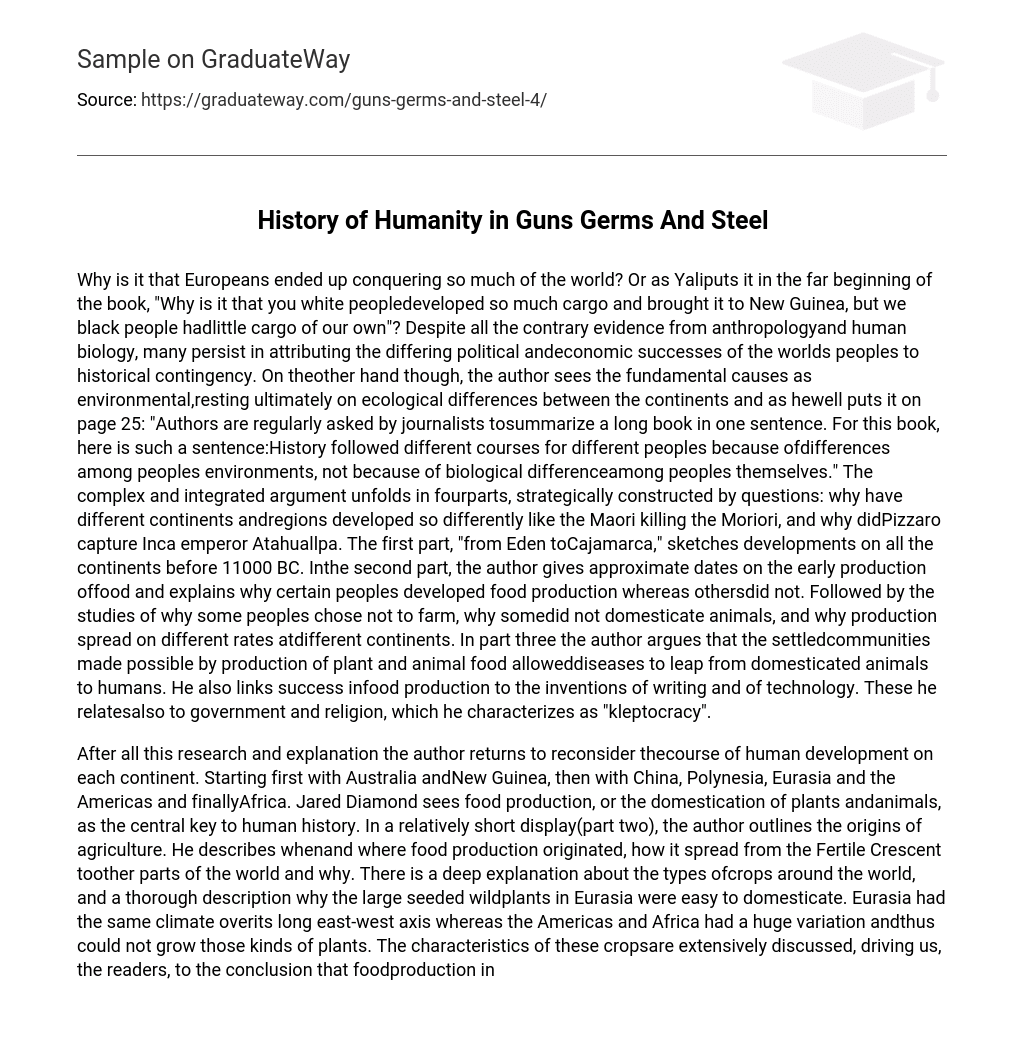Why is it that Europeans ended up conquering so much of the world? Or as Yaliputs it in the far beginning of the book, “Why is it that you white peopledeveloped so much cargo and brought it to New Guinea, but we black people hadlittle cargo of our own”? Despite all the contrary evidence from anthropologyand human biology, many persist in attributing the differing political andeconomic successes of the worlds peoples to historical contingency. On theother hand though, the author sees the fundamental causes as environmental,resting ultimately on ecological differences between the continents and as hewell puts it on page 25: “Authors are regularly asked by journalists tosummarize a long book in one sentence. For this book, here is such a sentence:History followed different courses for different peoples because ofdifferences among peoples environments, not because of biological differenceamong peoples themselves.” The complex and integrated argument unfolds in fourparts, strategically constructed by questions: why have different continents andregions developed so differently like the Maori killing the Moriori, and why didPizzaro capture Inca emperor Atahuallpa. The first part, “from Eden toCajamarca,” sketches developments on all the continents before 11000 BC. Inthe second part, the author gives approximate dates on the early production offood and explains why certain peoples developed food production whereas othersdid not. Followed by the studies of why some peoples chose not to farm, why somedid not domesticate animals, and why production spread on different rates atdifferent continents. In part three the author argues that the settledcommunities made possible by production of plant and animal food alloweddiseases to leap from domesticated animals to humans. He also links success infood production to the inventions of writing and of technology. These he relatesalso to government and religion, which he characterizes as “kleptocracy”.
After all this research and explanation the author returns to reconsider thecourse of human development on each continent. Starting first with Australia andNew Guinea, then with China, Polynesia, Eurasia and the Americas and finallyAfrica. Jared Diamond sees food production, or the domestication of plants andanimals, as the central key to human history. In a relatively short display(part two), the author outlines the origins of agriculture. He describes whenand where food production originated, how it spread from the Fertile Crescent toother parts of the world and why. There is a deep explanation about the types ofcrops around the world, and a thorough description why the large seeded wildplants in Eurasia were easy to domesticate. Eurasia had the same climate overits long east-west axis whereas the Americas and Africa had a huge variation andthus could not grow those kinds of plants. The characteristics of these cropsare extensively discussed, driving us, the readers, to the conclusion that foodproduction indeed played a major role in a material sense, mental sense, as anagent of civilization and as a source of power. Firstly, the author argues thatancient farmers had to develop more advanced tools for producing more amounts offood and had the opportunity to support people that did not work in the fields,such as politicians, warriors, priests and so on. As a result of that, farmersbecame materialistically richer than hunter-gatherers who stayed in relativelysmall groups, because hunters could not support people that were not able tohunt and kill wild animals. More food available meant, and still does, morepeople. More people to feed requires better technology and also soldiers toguard, politicians to make laws, priests to have as spiritual leaders and so on.
Through this argument we can see that new techniques were being invented and newlevels of hierarchy as well. So, in a nutshell, with food as basis the farmerswere able to first build the materials, then establish some sort of ahierarchical system, which led to the invention of the alphabet and the rise ofmajor civilizations. A similar analysis is carried out for the domestication oflarge mammals. Here, again, Eurasia was favored with almost all the suitablespecies. The author in this particular section gives modern examples of modernanimal breeders that were not able to domesticate some wild large mammals ofAfrica and justifies why ancient Africans and other peoples could notdomesticate them either. Then, he continues on to demonstrate that when largeanimals such as horses became available to some of those peoples, such as theNative Americans, they adopted them and made use of them. Guns, Germs and Steelis a fascinating synthesis that brings together history, archaeology,agriculture, linguistics, medicine, evolution and many other fields. We can seethat the writer starts off the book with a notable amount of frustration aboutthe mistaken ideas our society has come to believe: ” … objection to suchracist explanations is not just that they are loathsome, but also that they arewrong. …evidence for the existence of human differences in intelligence… islacking. …modern “Stone Age” people are probably more intelligent … thanindustrial peoples” (page 19). Through these strong words we can see that hewill try to convince people that there was something else holding people backand there is not such a thing as a superior race. There are a lot of rock solidclever arguments in this book about writing, language and how people came aboutto where we stand today. Studying extensively the history of World War II,Ive attained the belief of cause and effect and the writer describes almostall of his arguments giving out a strong case. The only thing that I did notquite grasp, was the quick description of the Spaniards conquest ofMesoamerica; what exactly caused the Spaniards to capture the natives, since thenatives were not a thread to them? Besides that, I believe Guns, Germs and Steelwas a very well structured, extensively researched and superbly presented book.
Reading this was actually a different experience, because it covers and explainsin a nutshell how, when and why we are here today.





